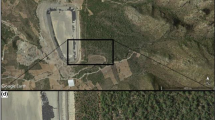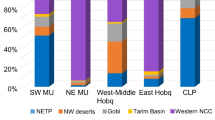Abstract
After the deceleration of the postglacial marine transgression, the German North Sea coast was subject to deposition of a complex pattern of subtidal to terrestrial facies. This study aims at reconstructing these facies changes in the ‘Land Wursten’ region (Lower Saxony) by focussing on so-called dwog horizons (incipient soil horizons of the pre-engineered salt marshes). We explore their implications for relative sea-level reconstructions and their indication for early settlement activities. Archive drilling data (1960, provided by the ‘Landesamt für Bergbau, Energie und Geologie’) were analysed to create five high-resolution stratigraphic cross sections. Three new drilling records were subjected to sedimentological and microfaunal investigations and interpreted to verify and calibrate the archive data. Two dwog horizons were found and 14C-AMS dated. We found basal salt marsh deposits inundated by a high-energy event and covered by tidal flat sediments. The thick tidal flat unit is again overlain by salt marsh deposits indicating the transition from a shallow marine to a terrestrial environment where dwogs were developed and covered by episodic marine incursions. The ages of the dwogs (1128–969 cal BC; cal AD 1426–1467) do not correlate with known layers of adjacent settlement sites and are critically discussed. However, we show that they correlate with phases of stagnant regional relative sea level (RSL) and can be used as RSL indicators. The combined archive and modern data provide valuable information for the RSL reconstruction and palaeoenvironmental changes. However, further research is recommended to accomplish more detailed information about coastal response during the Holocene sea-level changes and implications for settlement dynamics.











Similar content being viewed by others
References
Ad-hoc-Arbeitsgruppe Boden (2005) Bodenkundliche Kartieranleitung, 5th edn. Bundesanstalt für Geowissenschaften und Rohstoffe, Hannover
Allen JRL (1999) Geological impacts on coastal wetland landscapes: some general effects of sediment autocompaction in the Holocene of Northwest Europe. The Holocene 9:1–12. doi:10.1191/095968399674929672
Asmus WD (1949) Neuere Ausgrabungen in der Eisenzeitlichen Dorfsiedlung auf der Barward bei Dingen. Kr Wesermünde Hammaburg 2:116–130
Aufderhaar I (2016) Sievern, Ldkr. Cuxhaven – Analyse einer Zentralregion von der ausgehenden Vorrömischen Eisenzeit bis in das 6. Jh. n. Chr. Studies in Landscape and Settlement History in the Southern North Sea Region 8, Wilhelmshaven
Aufderhaar I, Brandt I, Schwank S, Siegmüller A (2013) Aktuelle Untersuchungen im Umfeld der Wurt Fallward, Ldkr Cuxhaven. Nachrichten des Marschenrates zur Förderung der Forschung im Küstengebiet der Nordsee 50:41–44
Baeteman C (1999) The Holocene depositional history of the Ijzer palaeovalley (western Belgian coastal plain) with reference to the factors controlling the formation of intercalated peat beds. Geol Belg 2:39–72
Barsch H, Billwitz K, Bork H (eds) (2000) Arbeitsmethoden in Physiogeographie und Geoökologie. Justus Perthes Verlag Gotha GmbH, Gotha
Beets DJ, van der Spek AJF (2000) The Holocene evolution of the barrier and back-barrier basins of Belgium and the Netherlands as a function of late Weichselian morphology, relative sea-level rise and sediment supply. Geol Mijnb 79:3–16. doi:10.1017/S0016774600021533
Behre K-E (2004) Coastal development, sea-level change and settlement during the later Holocene in the Clay District of lower Saxony (Niedersachsen), northern Germany. Quatern Int 112:37–53. doi:10.1016/S1040-6182(03)00064-8
Behre K-E (2007) A new Holocene Sea-level curve for the southern North Sea. Boreas 36:82–102. doi:10.1111/j.1502-3885.2007.tb01183.x
Blott SJ, Pye K (2001) Gradistat: a grain size distribution and statistics package for the analysis of unconsolidated sediments. Earth Surf Proc Land 26:1237–1248. doi:10.1002/esp.261
Blume HP, Stahr K, Leinweber P (2011) Bodenkundliches Praktikum. Eine Einführung in pedologische Arbeiten für Ökologen, Land- und Forstwirte, Geo- und Umweltwissenschaftler. Spektrum, Heidelberg
Brain MJ, Long AJ, Woodroffe SA, Petley DN, Milledge DG, Parnell AC (2012) Modelling the effects of sediment compaction on salt marsh reconstructions of recent sea-level rise. Earth Planet Sc Lett 345–348:180–193. doi:10.1016/j.epsl.2012.06.045
Brand G, Hagemann BP, Jelgersma S, Sindowski K-H (1965) Die lithostratigraphische Unterteilung des marinen Holozäns an der Nordseeküste. Geol Jahrb 82:365–384
Bruns I, Bungenstock F, Wolters S, Freund H (2015) Klastische Lagen in eingeschalteten Torfen im niedersächsischen Küstenholozän–Anzeiger für synsedentäre oder postsedentäre Einzelereignisse. Siedlungs- und Küstenforschung im südlichen Nordseegebiet 38:257–269
Bungenstock F (2008) Zur Paläogeographie des jungbronze- bis früheisenzeitlichen Siedlungsplatzes Rodenkirchen-Hahnenkooper Mühle, Ldkr Wesermarsch. Probleme der Küstenforschung im südlichen Nordseegebiet 32:181–195
Bungenstock F, Schäfer A (2009) The Holocene relative sea-level curve for the tidal basin of the barrier island Langeoog, German bight, southern North Sea. Glob Planet Chang 33:34–51. doi:10.1016/j.gloplacha.2008.07.007
Bungenstock F, Weerts HJT (2010) The high-resolution Holocene sea-level curve for Northwest Germany: global signals, local effects or data-artefacts? Int J Earth Sci 99:1687–1706. doi:10.1007/s00531-009-0493-6
Bungenstock F, Weerts HJT (2012) Holocene relative sea-level curves for the German North Sea coast. Int J Earth Sci 101:1083–1090. doi:10.1007/s00531-011-0698-3
Busschers FS, Kasse C, van Balen RT, Vandenberghe J, Cohen KM, Weerts HJT, Wallinga J, Johns C, Cleveringa P, Bunnik FPM (2007) Late Pleistocene evolution of the Rhine-Meuse system in the southern North Sea basin: imprints of climate change, sea-level oscillation and glacio-isostacy. Quaternary Sci Rev 26:3216–3248. doi:10.1016/j.quascirev.2007.07.013
De Deckker P, Forester RM (1988) The use of ostracods to reconstruct continental palaeoenvironmental records. In: De Deckker P, Colin JP, Peypouquet JP (eds) Ostracoda in the earth sciences. Elsevier, Amsterdam, Oxford, pp 175–199
Dietze E, Hartmann K, Diekmann B, Ijmker J, Lehmkuhl F, Opitz S, Stauch G, Wünnemann B, Borchers A (2012) An end-member algorithm for deciphering modern detrital processes from lake sediments of Lake Donggi, NE Tibetan plateau, China. Sediment Geol 243–244:169–180. doi:10.1016/j.sedgeo.2011.09.014
Eshel G, Levy GJ, Mingelgrin U, Singer MJ (2004) Critical evaluation of the use of laser diffraction for particle-size distribution analysis. Soil Sci Soc Am J 68:736–743. doi:10.2136/sssaj2004.7360
Falk GC (2003) Die Paläogeomorphologie ausgewählter Standorte der Schleswig-Holsteinischen Nordseeküste in Früh- und Mittelholozän. PhD thesis. Technische Universität Berlin
Folk RL, Ward WC (1957) Brazos River bar: a study in the significance of grain size parameters. J Sediment Petrol 27:3–26. doi:10.1306/74D70646-2B21-11D7-8648000102C1865D
Forester RM (1988) Nonmarine calcareous microfossil sample preparation and data acquisition procedures. US Geological Survey Technical Procedure HP-78(R1):1–9
Frenzel P, Boomer I (2005) The use of ostracods from marginal marine, brackish waters as bioindicators of modern and Quaternary environmental change. Palaeogeogr Palaeocl 225:68–92. doi:10.1016/j.palaeo.2004.02.051
Frenzel P, Tech T, Bartholdy J (2005) Checklist and annotated bibliography of recent Foraminiferida from the German Baltic Sea coast. Stud Geol Polon 124:67–85
Freund H, Streif H (2000) Natürliche Pegelmarken für Meeresspiegelschwankungen der letzten 2000 Jahre im Bereich der Insel Juist. Petermann Geogr Mitt 143:34–45
Genrich (1941) Bericht über die Untersuchungen auf der Barward. Probleme der Küstenforschung im südlichen Nordseegebiet 2:157–170
Gerdes G, Petzelberger BEM, Scholz-Böttcher BM, Streif H (2003) The record of climatic change in the geological archives of shallow marine, coastal and adjacent lowland areas of northern Germany. Quaternary Sci Rev 22:101–124. doi:10.1016/S0277-3791(02)00183-X
Haarnagel W (1979) Die Grabung Feddersen Wierde. Methode, Hausbau, Siedlungs- und Wirtschaftsformen sowie Sozialstruktur. Textband. Steiner, Wiesbaden
Hammer Ø, Harper DAT, Ryan PD (2001) PAST: Palaeontological statistics software package for education and data analysis. Palaeontol Electron 4(1):article4
Handl M, Mostafawi N, Brückner H (1999) Ostracodenforschung als Werkzeug der Paläogeographie. In: Brückner H (ed) Dynamik, Datierung, Ökologie und Management von Küsten. Marburger Geographische Schriften 134:116–153
Hayen H, Tidow K, Ullemeyer R (1981) Einzeluntersuchungen zur Feddersen Wierde. Steiner, Wiesbaden
Hesemann M (2015) The foraminifera.eu database: concept and status. Palaeontol Electron 18.3.48A: 1–14
Horton BP, Edwards RJ (2006) Quantifying Holocene Sea level chance using intertidal foraminifera: lessons from the British isles, vol 40. Special Publication, Cushman Foundation for Foraminiferal Research
Hoselmann C, Streif H (2004) Holocene sea-level rise and its effect on the mass balance of coastal deposits. Quatern Int 112:89–103. doi:10.1016/S1040-6182(03)00067-3
Kalis AJ, Merkt J, Wunderlich J (2003) Environmental changes during the Holocene climatic optimum in Central Europe – human impact and natural causes. Quaternary Sci Rev 22:33–79. doi:10.1016/S0277-3791(02)00181-6
Kiden P, Denys L, Johnston P (2002) Late Quaternary sea-level change and isostatic and tectonic land movements along the Belgian–Dutch North Sea coast: geological data and model results. J Quaternary Sci 17:535–546. doi:10.1002/jqs.709
Kiden P, Makaske B, van de Plassche O (2008) Waarom verschillen de zeespiegel—reconstructies voor Nederland? Gronboor Hamer 3(4):54–61
Lambeck K, Rouby H, Purcell A, Sun Y, Sambridge M (2014) Sea level and global ice volumes from the last glacial maximum to the Holocene. P Natl Acad Sci USA 111:15296–15303. doi:10.1073/pnas.1411762111
LBEG (2016) Geologische Küstenkarte von Niedersachsen 1: 25 000 – Relief der Holozänbasis http://nibis.lbeg.de/net3/public/ikxcms/default.aspx?pgid=151. Accessed 28 June 2016
Lehmann G (2000) Vorkommen, Populationsentwicklung, Ursache fleckenhafter Besiedlung und Fortpflanzungsbiologie von Foraminiferen in Salzwiesen und Flachwasser der Nord- und Ostseeküste Schleswig-Holsteins. PhD thesis. University of Kiel
Long AJ, Waller MP, Supples P (2006) Driving mechanisms of coastal change: peat compaction and the destruction of late Holocene coastal wetlands. Mar Geol 225:63–84. doi:10.1016/j.margeo.2005.09.004
Mehra OP, Jackson ML (1958) Iron oxide removal from soils and clays by a dithionite-citrate system buffered with sodium bicarbonate. Clay Clay Miner 7(1):317–327. doi:10.1346/CCMN.1958.0070122
Müller-Ahlten W (1994) Zur Genese der Marschböden. II. Kalksedimentation, Entkalkung. J Plant Nutr Soil Sc 157:333–343. doi:10.1002/jpln.19941570504
Murray JW (2006) Ecology and applications of benthic foraminifera. Cambridge University Press, Cambridge
Paul MA, Barras BF (1998) A geotechnical correction for post-depositional sediment compression: examples from the forth valley, Scotland. J Quaternary Sci 13:171–176. doi:10.1002/(SICI)1099-1417(199803/04)13:2<171::AID-JQS369>3.0.CO;2-Z
Pint A, Frenzel P, Horne DJ, Franke J, Daniel T, Burghardt A, Funai B, Lippold K, Daut G, Wennrich V (2015) Ostracoda from inland waterbodies with saline influence in Central Germany: implications for palaeoenvironmental reconstruction. Palaeogeogr Palaeocl 419:37–46. doi:10.1016/j.palaeo.2014.07.042
Reimer PJ, Bard E, Bayliss A, Beck JW, Blackwell PG, Ramsey CB, Buck CE, Cheng H, Edwards RL, Friedrich M, Grootes PM, Guilderson TP, Haflidason H, Hajdas I, Hatté C, Heaton TJ, Hoffmann DL, Hogg AG, Hughen KA, Kaiser KF, Kromer B, Manning SW, Niu M, Reimer RW, Richards DA, Scott EM, Southon JR, Staff RA, Turney CSM, van der Plicht J (2013) IntCal13 and Marine13 radiocarbon age calibration curves 0–50,000 years cal BP. Radiocarbon 55:1869–1887. doi:10.2458/azu_js_rc.55.16947
Schmid P (1978) Siedlung und Wirtschaft in den Jahrhunderten vor und nach der Zeitwende im Küstengebiet der südlichen Nordsee. Berichte zur deutschen Landeskunde 52:137–157
Schneeberg HA (1962) Beiheft zur geologisch-bodenkundlichen Karte 1:5000, Blatt Imsum-Ost. Niedersächsisches Landesamt für Bodenforschung, Hannover
Schoute JFT, Griede JW, Mook WG, Roeleveld W (1981) Radiocarbon dating of vegetation horizons. Geol Mijnb 60:453–459
Schwertmann U (1964) Differenzierung der Eisenoxide des Bodens durch Extraktion mit Ammoniumoxalat-Lösung. J Plant Nutr Soil Sc 105:194–202. doi:10.1002/jpln.3591050303
Streif H (1971) Stratigraphie und Faziesentwicklung im Küstengebiet von Woltzeten in Ostfriesland. Beihefte zum Geologischen Jahrbuch 119, Hannover
Streif H (1990) Das Ostfriesische Küstengebiet. Nordsee, Inseln, Watten und Marschen. Sammlung Geologischer Führer 57. Gebr. Borntraeger, Berlin, Stuttgart
Streif H (2004) Sedimentary record of Pleistocene and Holocene marine inundations along the North Sea coast of lower Saxony, Germany. Quatern Int 112:3–28. doi:10.1016/S1040-6182(03)00062-4
Tamm O (1932) Über die Oxalat-Methode in der chemischen Bodenanalyse. Medd Stat Skogsforsoks Stockholm 27:1–20
Vink A, Steffen H, Reinhardt L, Kaufmann G (2007) Holocene relative sea-level change, isostatic subsidence and the radial viscosity of the mantle of Northwest Europe (Belgium, the Netherlands, Germany, southern North Sea). Quaternary Sci Rev 26:3249–3275. doi:10.1016/j.quascirev.2007.07.014
Wartenberg W, Vött A, Freund H, Hadler H, Freche M, Willershäuser T, Schnaidt S, Fischer P, Obrocki L (2013) Evidence of isochronic transgressive surface within the Jade Bay tidal flat area, southern German North Sea coast – Holocene event horizons of regional interest. Z Geomorphol (Suppl) 57(4):229–256. doi:10.1127/0372-8854/2013/S-00150
WoRMS Editorial Board (2016) World Register of Marine Species. URL: http://www.marinespecies.org. Accessed 12 Jul 2016. doi:10.14284/170
Acknowledgements
The ‘Landesamt für Bergbau, Energie und Geologie’ in Hannover is acknowledged for providing access to the archive of drilling records. We thank David Scheder for considerable help during field campaigns, Peter Frenzel for thecreation of the scanning electron microscope images and Ines Bruns for support in the application of GeODin. Radiocarbon dating was funded through a Max Delbrück Prize for Junior Researchers awarded to Max Engel, a measure of the future concept of the University of Cologne in the framework of the Excellence Initiative (DFG ZUK 81/1).
Author information
Authors and Affiliations
Corresponding author
Electronic supplementary material
ESM 1
(PDF 3.89 mb)
Rights and permissions
About this article
Cite this article
Scheder, J., Engel, M., Bungenstock, F. et al. Fossil bog soils (‘dwog horizons’) and their relation to Holocene coastal changes in the Jade Weser region, southern North Sea, Germany. J Coast Conserv 22, 51–69 (2018). https://doi.org/10.1007/s11852-017-0502-z
Received:
Revised:
Accepted:
Published:
Issue Date:
DOI: https://doi.org/10.1007/s11852-017-0502-z




